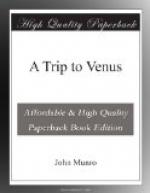“The green ball, next to Venus, is, I need hardly say, our own dear little world. Terra, or the earth, is 93 million miles from the sun, goes round him in 365 days, and turns on her axis in 24 hours less four minutes. Her diameter is 7,918 miles, and her density is 5.66 times that of water. She is attended by a single satellite, the moon, which revolves round her in 27.3 days, at a distance of 238,000 miles. The moon rotates on her axis in about the same time, and hence we can only see one side of her. She is 2,160 miles in diameter, but her mass is only one-eightieth that of the earth. A pound weight on the moon would scale six pounds on the earth. Having little or no atmosphere or water, she is apparently a dead world.
“The red planet beyond the earth is Mars, who appears in the sky as a ruddy gold or coppery star. He is 141 million miles from the sun, travels his orbit in 687 days, and wheels round his axis in 24 hours 37 minutes. His diameter is 4,200 miles, and his mass about one-ninth that of the earth. A body weighing two pounds on the earth would only make half a pound on Mars. As you know, his atmosphere is clear and thin, his surface flat, and subject to floods from the melting of the polar snows. Mars is evidently a colder and more aged planet than the earth.
“He is accompanied by two little moons, Phobos (Fear), which is from ten to forty miles in diameter, and revolves round him in 7 hours 39 minutes, at a distance of 6,000 miles, a fact unparalleled in astronomy; and Deimos (Rout), who completes a revolution in 30 hours 18 minutes, at a distance of 14,500 miles.
“About 400 planetoids have been discovered up to now, but we are always catching more of them. Medusa, the nearest, is 198 million miles, and Thule, the farthest, is 396 million miles from the sun. Vesta, the brightest and probably the largest, a pale yellow, or, as some say, bluish white orb, visible with the naked eye, is from 200 to 400 miles in diameter. It is impossible to say which is the smallest. Probably the mass of the whole is not greater than one quarter that of the earth.
“Jupiter, surnamed the ‘giant planet,’ who almost rivals Venus in her splendour, is 480 million miles from the sun; travels round his orbit in 12 years less 50 days; and is believed to whirl round his axis in 10 hours. His diameter is 85,000 miles, and his bulk is not only 1,200 times that of the earth, but exceeds that of all the other planets put together. Nevertheless, his mass is only 200 to 300 times that of the earth, for his density is not much greater than that of water. What we see is evidently his vaporous atmosphere, which is marked by coloured spots and bands or belts, probably caused by storms and currents, especially in the equatorial regions. Jupiter is thought to be self luminous, at least in parts, and is, perchance, a cooling star, not yet entirely crusted over.
“Four or five numbered satellites, about the size of our moon and upwards, are circulating round him in orbits from 2,000 to 1,000,000 miles distant in periods ranging from 11 hours to 16 days 18 hours.




